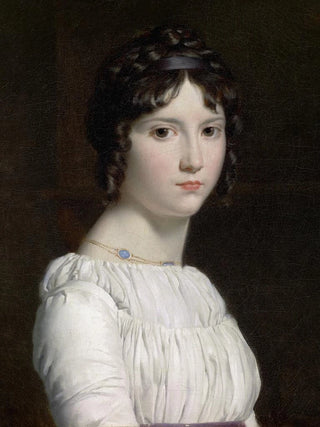Art print | Portrait of Alexandrine Émilie Brongniart - François Gérard


View from behind

Frame (optional)
In the fascinating world of art, some works transcend time and space, captivating the mind and soul of viewers. The "Portrait of Alexandrine Émilie Brongniart" by François Gérard fits into this tradition. This painting, which immortalizes the beauty and elegance of a woman from high society in the early 19th century, is much more than a simple representation. It evokes an era when art and fashion intertwined harmoniously, and where each brushstroke told a story. Gérard, with his unparalleled talent, manages to capture not only the physical appearance of his model but also her essence, her character, and her social status.
Style and uniqueness of the work
François Gérard's style is inseparable from Neoclassicism, an artistic movement advocating a return to the forms and ideals of Antiquity. In the "Portrait of Alexandrine Émilie Brongniart," one can observe the finesse of details, the delicacy of colors, and the harmony of proportions. Alexandrine Émilie's face, illuminated by soft light, appears almost alive, while her gaze, both penetrating and dreamy, invites the viewer to delve into her thoughts. The drapes of her dress, skillfully crafted, demonstrate remarkable technical mastery, where each fold seems sculpted with care. This work also stands out for its intimate atmosphere, where the neutral background allows the subject to stand out, thus enhancing the emotional impact of the composition.
The artist and his influence
François Gérard, born in 1770, is one of the most renowned portraitists of his time. Trained under Jacques-Louis David, he developed a distinctive style that combines grandeur and sensitivity. His work marked the transition from Neoclassicism to Romanticism, influencing a generation of artists who followed him. Gérard had the honor of painting many prominent figures of his era, ranging from nobility to political figures. His approach to portraiture, which combines realism and idealization, redefined the standards of artistic representation. Through

Matte finish

View from behind

Frame (optional)
In the fascinating world of art, some works transcend time and space, captivating the mind and soul of viewers. The "Portrait of Alexandrine Émilie Brongniart" by François Gérard fits into this tradition. This painting, which immortalizes the beauty and elegance of a woman from high society in the early 19th century, is much more than a simple representation. It evokes an era when art and fashion intertwined harmoniously, and where each brushstroke told a story. Gérard, with his unparalleled talent, manages to capture not only the physical appearance of his model but also her essence, her character, and her social status.
Style and uniqueness of the work
François Gérard's style is inseparable from Neoclassicism, an artistic movement advocating a return to the forms and ideals of Antiquity. In the "Portrait of Alexandrine Émilie Brongniart," one can observe the finesse of details, the delicacy of colors, and the harmony of proportions. Alexandrine Émilie's face, illuminated by soft light, appears almost alive, while her gaze, both penetrating and dreamy, invites the viewer to delve into her thoughts. The drapes of her dress, skillfully crafted, demonstrate remarkable technical mastery, where each fold seems sculpted with care. This work also stands out for its intimate atmosphere, where the neutral background allows the subject to stand out, thus enhancing the emotional impact of the composition.
The artist and his influence
François Gérard, born in 1770, is one of the most renowned portraitists of his time. Trained under Jacques-Louis David, he developed a distinctive style that combines grandeur and sensitivity. His work marked the transition from Neoclassicism to Romanticism, influencing a generation of artists who followed him. Gérard had the honor of painting many prominent figures of his era, ranging from nobility to political figures. His approach to portraiture, which combines realism and idealization, redefined the standards of artistic representation. Through






